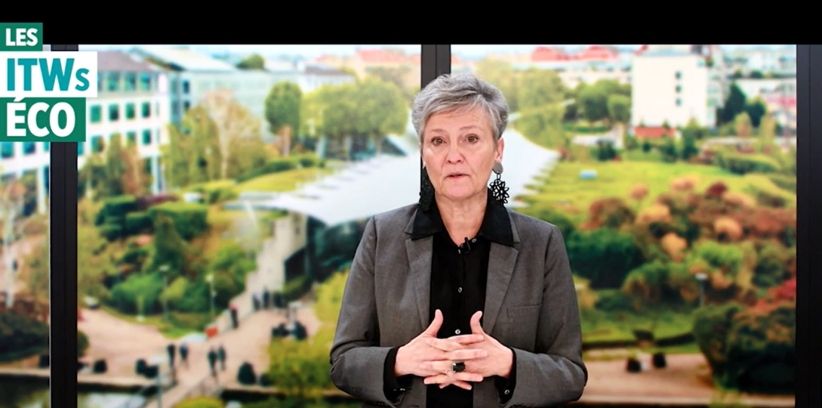
UNITED KINGDOM – Green transition: mid-point review
The United Kingdom has made notable progress in transitioning towards a low-carbon economy. It became the first country to halve its territorial greenhouse gas (GHG) emissions1 between 1990 and 2022, mostly thanks to a big shift away from coal and towards energy from renewable sources.
However, the hardest part is still to come: electrifying the industrial and agricultural sectors, financing the thermal renovation of buildings, investing massively in innovative carbon capture and storage solutions, and so on.
A pioneer in the fight against global warming, the UK was the first G7 country to pass legislation setting out clear targets for reducing GHG emissions (the Climate Change Act 2008). Its Net Zero Strategy, published on 19 October 2021, sets out planned actions and the government’s commitments in each sector to achieve the target reduction in GHG emissions by 2050. One of the targets laid down in the strategy is for the UK to be powered entirely by clean energy (which includes not only energy from renewable sources but also nuclear power), subject to security of supply, by 2035. In reality, the UK’s strategy is to deliver a low-carbon transition focused on reducing GHG emissions rather than a genuine energy transition based solely on developing energy from renewable sources, which would entail moving away from nuclear power. Pragmatism and realism are thus at the heart of the UK’s net-zero strategy.
Despite its increased strategic transparency and strong performance when it comes to hitting GHG reduction targets, the UK’s current government has been severely criticised for chronic delays in implementing its programme and for backpedalling on key commitments and thus jeopardising its ability to hit its stated targets. In its most recent assessment, published in 2023, the Climate Change Committee (CCC, an independent expert body established by the 2008 Act) lamented the lack of progress in areas other than energy generation and said the UK’s medium-term targets would, in its judgement, be difficult to achieve. It bemoaned the fact that the government had rowed back on its fossil fuel commitments, authorising a new coal mine (even though coal from the latter will be used to make steel and not to generate electricity, with the government maintaining its target of phasing out coal from power generation by 1 October 2024) and handing out new North Sea oil and gas licences. Given the sharp decline in the government’s credibility when it comes to combating climate change and delays in formulating and implementing urgent actions, Climate Action Tracker (CAT) thinks the UK’s 2030 emissions target is no longer compatible with the 2015 Paris Agreement target of limiting the rise in temperatures to 1.5°C; in other words, the UK needs to cut its emissions more quickly if it is to meet the 1.5°C target.
Existing work on the cost of the green transition for the economy as a whole and its various sectors, including the public sector, estimates the net cost of the transition over the period 2020-2050 at £321 billion, with €1,312 billion of capital expenditure partially offset by €991 billion of operational savings. The energy and construction sectors account for the lion’s share of this net cost. This is because transitioning the rest of the economy to low-carbon energy will require a big increase in electricity generation and reducing carbon emissions from buildings is expensive. The biggest cost reduction comes from vehicles thanks to the savings generated. Net operational savings are expected to exceed capital expenditure from 2040; by 2050, annual net savings are expected to be around £19 billion (0.6% of 2050 GDP).
As regards the economic impact of the green transition, according to the CCC there might well be a non-negligible increase in GDP (of around 2% by 2030 and 3% in the long term), accompanied by around a 1% increase in employment. This is mainly down to the substantial public and private investment needed to transition to a low-carbon economy (rising from £10 billion in 2020 to an average of nearly £50 billion a year from 2027 onwards). Lastly, the impact on the public accounts would be a gradual deterioration in the public deficit, which would rise to 5% of GDP in 2050/2051 – 2.3 percentage points above the no-decarbonisation scenario – as a result of transition-related expenditure and the loss of some tax receipts (e.g. fuel duty).
In conclusion, the green transition presents opportunities for the UK economy. According to McKinsey, the global green transition could create opportunities worth £1 trillion to UK businesses by 2030 – a figure also quoted by the UK Government. The transition offers long-term opportunities for the UK’s financial services sector. The government says global sustainable finance assets under management are forecast to reach $34 trillion by 2026, outpacing growth in the asset and wealth management sector as a whole. The government thus plans on supporting the UK’s financial sector to ensure it secures a significant share of this market.
To find out more, read the full paper United Kingdom – Green transition: mid-point review
1. The main greenhouse gases in the UK are carbon dioxide (80% of total GHG emissions in 2022), methane (14%), nitrous oxide (4%) and fluorogases (2%). See the 2022 UK Greenhouse Gas Emissions report.





